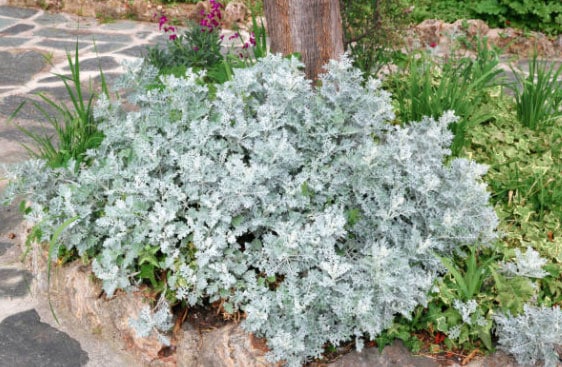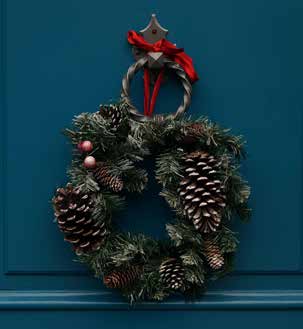
Incorporate nature into your holiday decor
CHEERS TO OUR Vigorous, Brilliant EVERGREENS
Every season has its own stars in our landscape here in the Mid-Atlantic. In December we admire our evergreens — the cedars and spruce, hollies and magnolias. Consistently and comfortingly green, with flashes of red, they symbolize hope and joy through our darkest days. Here’s to the trees and shrubs that cheer us through winter!
CONIFEROUS TREES
Because evergreens keep their foliage or needles year-round, they are a welcome addition to any yard. Evergreens provide year-round cover in addition to winter shelter and nesting sites for birds. They also provide sap, cones, seeds, needles, twigs, and bud throughout the year, creating a continuous food source for wildlife. Here are a few popular varieties:
- Dwarf Alberta Spruce (Picea glauca ‘Conica’) are evergreen conifers with a classic pyramidal Christmas tree shape that rarely exceeds 13 feet. This is a popular choice for foundation plantings as a large shrub or small specimen tree all over America. This dwarf version grows very slowly—about 2 to 4 inches per year. The aromatic green needles are about 3/4-inches long. The tree has a tight, densely-packed growth habit that gives dwarf Alberta spruce trees a “fuzzy” look. It is commonly kept in containers as a young shrub and adorned with Christmas tree ornaments and holiday ribbons during the winter months.
- Dwarf Cypress (Dwarf hinoki cypress) is similar to Dwarf Albert Spruce in that it is often potted as a small tree for Christmas. Deep green in color, scaly in texture, and rounded in shape, its foliage is arranged in flattened sprays that fan out at the ends of the branches. This evergreen shrub has the potential to reach about 6 feet tall and nearly as wide, with a pyramidal shape. It is extremely slow growing, however, putting on just one to three inches of growth each year and remaining flat-topped or rounded during the first decade of its life in the garden.
- Arborvitae (Thuja occidentalis), also known as Northern white cedar, are fast-growing cylindrical trees that grow from 3 to 70 feet tall. Their dense foliage provides excellent cover year-round for wildlife. Species such as songbirds, waterfowl, and small mammals all benefit from Arborvitae. This tree grows best in wet, calcareous (calcium-rich) soils. These easy-care evergreen trees are often used as a privacy screen or hedge.
- Eastern Red Cedar (Juniperus virginiana) trees are found in dry-moist soils. These tolerate a wide range of soils and produce bluish-green berries from July to March. Many birds and small mammals eat the berry-like cones, especially in winter.
A good reference for identifying coniferous trees on your walks can be found at: www.dnr.maryland.gov/ wildlife/Documents/Basic_conifer_key.pdf
HOLLY
Holly is a genus of evergreen trees, shrubs, and climbers. Common holly (Illex aquifolium) is the species that has become synonymous with winter with its splash of vibrant green and bright red berries. There are many varieties that do well here, including these popular varieties:
- Nellie Stevens (Illex Nellie R. Stevens) is considered an ideal selection for both hedging and privacy screening, especially since it grows up to 3 feet each year. It has dark glossy leaves and red berries, thrives on neglect, and grows in partial sun or shade. It matures at 15 to 25 feet.
- American Holly (Ilex opaca)Fruiting branches from both wild and planted trees are popular Christmas decorations. Many improved varieties are grown for ornament, shade, and hedges. You must have both a male and female plant to have berries, or at least have the opposite sex growing wild somewhere nearby. Heights range from 25 feet to as tall as 60 feet.
- Inkberry (Ilex gabra)is a slow-growing broadleaf, broad growing evergreen shrub with a rounded-to-upright growth habit. It is easy to grow and offers good winter color. Its name is a reference to the fruits produced by the shrub, which grows to a height of 5 to 8 feet and can reach the same dimension wide. Female plants need a male pollinator to produce the berry-like fruits. It’s a good choice for areas of damp soil. Female plants need a male pollinator if you want them to produce the berry-like fruits.
- Winterberry (Ilex verticillata) is a native shrub that loses its leaves each autumn so it is not an evergreen. However, after the leaves have turned yellow and dropped, you are left with a breathtaking view of thousands of brightly colored berries clinging to every stem. The berries remain on the plant for several weeks to months through winter, as the birds tend not to be interested in them until they have softened considerably. Female plants need a male pollinator to produce the berry-like fruits. One male winterberry holly will pollinate up to five female plants. What a joy to see branches lined with bright red berries in the snow!
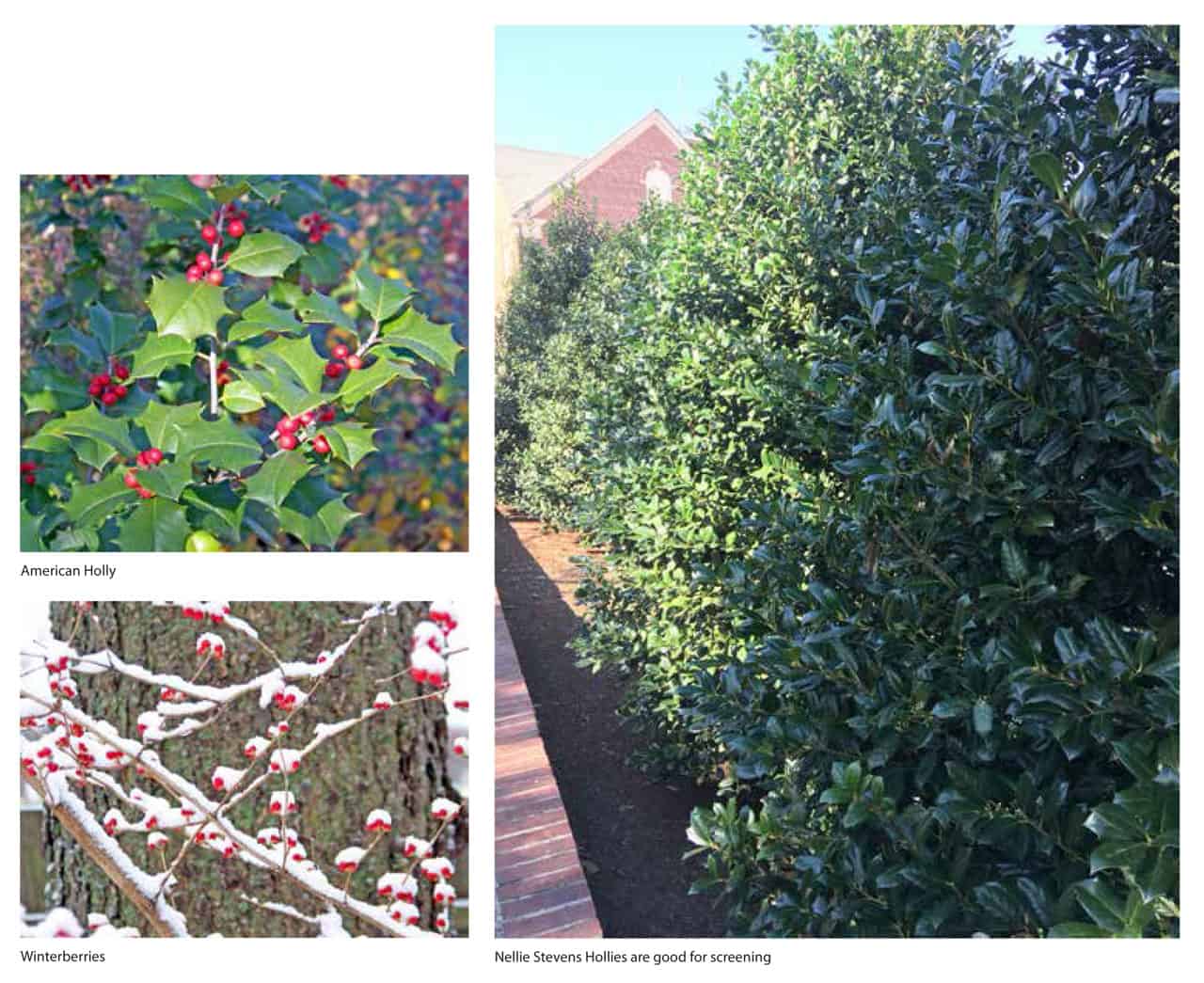
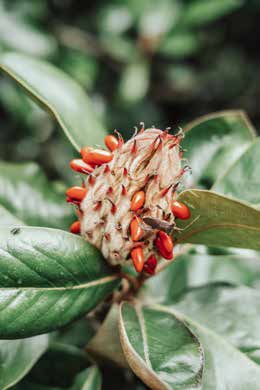
Magnolia flowers give way to spherical cone-like fruiting clusters (to 3-5” long) that mature in late summer to early fall, releasing individual rose-red coated seeds suspended on slender threads at maturity. Photo by Jocelyn Powell via Unsplash
MAGNOLIAS
One of the most elegant and showy ornamental trees is the evergreen Southern Magnolia (Magnolia grandiflora), which grows up to 80 feet tall. There are several magnolia evergreen varieties from which to choose. The lustrous green leaves are a standout feature with light green, silver, or reddish fuzzy undersides. There are many cultivars of Southern Magnolia that are available in the trade. Here are some of the most popular, which don’t grow quite as tall as their namesake but all are grandifloras:
- Sweetbay Magnolia (Magnolia virginiana) is semi-evergreen and is often grown as an ornamental tree in gardens and used in horticultural applications to give an architectural feel to landscape designs. It is an attractive tree for parks and large gardens, grown for its large, conspicuous, scented flowers, for its clean, attractive foliage, and for its fast growth.
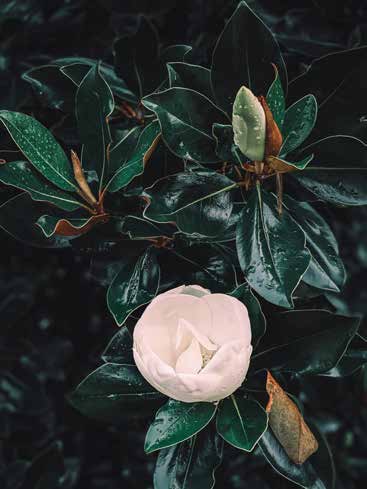
The glossy green leaves are often seen in holiday displays. White blossoms arrive in the spring and summer. Photo by Katelynn Ruffner via Unsplash
FURTHER ENHANCING YOUR LANDSCAPE
The landscapers at McFall and Berry are ready to help you with evergreens listed above and if you’d like to further enhance your winter landscape—say with purple or silver, try these ideas as well.
Yucca, Dusty Miller, and Pansies A variety of these plants give great winter color. Variegated Yucca can help to give contrasting color and texture to your perennial beds. Add in some Dusty Millers for a striking silver foliage and lacy texture. Top with some winter pansies is perfect as these flowers can be planted late October or November, but last until the spring season. See the picture below for ideal plant bed setup using these plants.
Cabbage and Kale Ornamental Cabbage and Kale are a great use of adding color to your planting bed while incorporating a winter veggie. These plants can survive temperatures as low as 5 degrees Fahrenheit, therefore, they will last well into December.
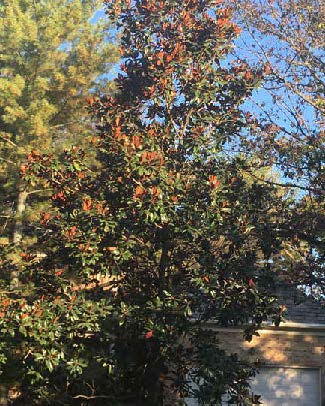
A Magnolia
INSTALL AND WATERING TIPS
We generally recommend to slowly install large plants in late November and early December. The best times of the year to plant are in the spring and fall.
- New trees will need to be watered every other day for the first 2-3 weeks. Each plant will need approximately the same amount of water as the gallon size of the plant (i.e., a 3-gallon root ball will require 3 gallons of water, a 5-gallon root ball will require 5 gallons of water.)
- Trees need a lot of water in their early planting stages to ensure overall health. Home Depot and other garden centers sell tree water bags. This allows you to fill the bags every few days with water to provide a slow drip watering solution. Another option is a drip line hose, but these tend to not provide sufficient water to establish the trees.
- Check your yard at different times of the day to gauge the shade/sun exposure. The maximum amount of sunlight will help the plants to thrive.
NUTRIENT/SOIL MANAGEMENT TIPS
- You will want to have the soil assessed prior to planting.
- Adding additional soil or starter fertilizers will be successful to the overall health of the plants.
- Tree rings should be mulched after installation and staked if needed.
- The best products to use for nutrients/fertilizers include Healthy Start “Roots” and Holly Tone.
DEER CONTROL TIPS
The deer population in Potomac has grown rapidly over the last decade.
- Young trees like hollies are prime candidates for young deer to nibble during soft leaf growth.
- Use diligently Deer Scram or Deer Off-style products to help deter the deer.
- Using stakes and deer netting to create a perimeter around the tree to help prevent deer damage.
INSECT CONTROL TIPS
- Please alert your McFall and Berry representative of any new installations so that we can add the plants to our Integrated Pest Management (IPM) program to prevent issues such as scale, molds, and insect issues.
- Most plants are treated in the dormant season or early spring with dormant oils and insecticidal soaps to help prevent insect/disease invasions.
- There are products available at Home Depot or other garden centers if you would like to complete intermittent treatments between contracted IPM visits.
